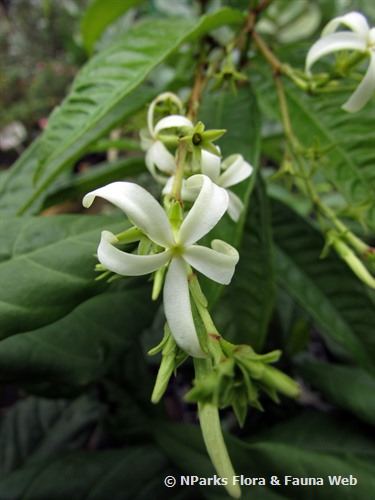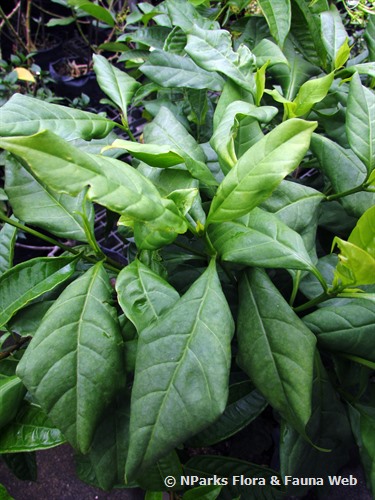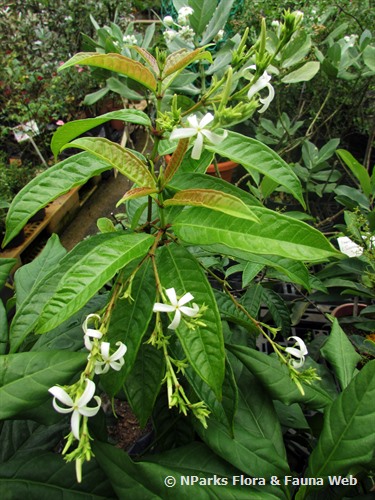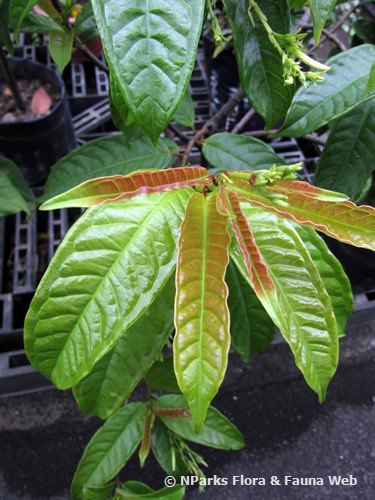
Back
Amphineurion marginatum (Roxb.) D.J.Middleton
| Family Name: | Apocynaceae |
| Synonyms: | Amphineurion acuminatum, Amphineurion velutinum, Chonemorpha cristata, Chonemorpha dichotoma, Echites apoxys, Echites cristatus, Echites marginatus |
| Common Name: | Common Aganosma, Ara Tanah, Sakat Lima, Sekati Lima, 香花藤 |
Name
Classifications and Characteristics
| Plant Division | Angiosperms (Flowering Seed Plants) (Dicotyledon) |
|---|---|
| Plant Growth Form | Climber, Shrub |
| Lifespan (in Singapore) | Perennial |
| Mode of Nutrition | Autotrophic |
Biogeography
| Native Distribution | Tropical Asia, China. |
|---|---|
| Native Habitat | Terrestrial |
Description and Ethnobotany
| Growth Form | It is a woody liana with greenish yellow latex, growing up to 8 m. |
|---|---|
| Foliage | Leaves are green, margin slightly wavy, leaf blade oblong, measuring up to 12 cm by 4 cm, with acuminate or caudate apex, base acute to rounded, and has 12 - 15 lateral veins. Leaf blade is hairy on the undersides along the veins. |
| Stems | The stems and branches are dotted with lenticels. |
| Flowers | Flowers are white to yellow, arranged in clusters called as cymes, axillary located, lobes are very narrowly elliptical. |
| Fruit | Brownish follicles, cylindrical shape. Seeds are oblong in shape and flat. |
| Habitat | Often found in montane forests. |
| Etymology | The genus Amphineurion is from Greek amphi which means both or surrounding, and neros which means water. The specific epithet marginatum means having a distinct margin, which refers to the leaves. |
| Ethnobotanical Uses | Medicinal: The roots decoction is used as a postpartum remedy and for urinary disorders. The roots and stems are said to be eaten for mental illness and schizophrenia. Others: The plant is said to have antioxidant and antiplasmodial properties. |
Landscaping Features
| Desirable Plant Features | Ornamental Flowers, Fragrant (Flowers) |
|---|
Plant Care and Propagation
| Light Preference | Full Sun, Semi-Shade |
|---|---|
| Water Preference | Moderate Water |
| Rootzone Tolerance | Moist Soils, Well-Drained Soils |
| Propagation Method | Seed, Stem Cutting |
Foliar
| Foliage Retention | Evergreen |
|---|---|
| Mature Foliage Colour(s) | Green |
| Foliar Type | Simple / Unifoliate |
| Foliar Arrangement Along Stem | Opposite |
| Foliar Attachment to Stem | Petiolate |
| Foliar Shape(s) | Non-Palm Foliage (Oblong) |
| Foliar Venation | Pinnate / Net |
| Foliar Margin | Entire - Wavy / Undulate |
| Foliar Apex - Tip | Acuminate, Caudate |
| Foliar Base | Acute, Rounded / Obtuse |
Floral (Angiosperm)
| Flower Colour(s) | White, Yellow / Golden |
|---|---|
| Flower Grouping | Cluster / Inflorescence |
| Flower Location | Axillary |
| Inflorescence Type | Cyme |
| Flowering Period | Free-Flowering |
Image Repository
Others
| Master ID | 32831 |
|---|---|
| Species ID | 7244 |
| Flora Disclaimer | The information in this website has been compiled from reliable sources, such as reference works on medicinal plants. It is not a substitute for medical advice or treatment and NParks does not purport to provide any medical advice. Readers should always consult his/her physician before using or consuming a plant for medicinal purposes. |




